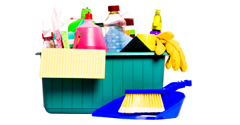
07 Jul Cleaning Products
DID YOU KNOW
Most cleaning products contain ingredients that are known skin and lung irritants. Women who use alot of cleaning products, air fresheners and insect repellants have a higher risk of breast cancer (Zota et al, 2010).
Chemical cleaning products were introduced after WW11 with the advent of the industrial revolution in the 20th century. As a result of an effective marketing strategy and a bit of paranoia, one of the world’s largest and most profitable industries – the chemical giants was born. Some how we’ve been convinced as a society that all germs are bad and that we need to use harsh chemicals to create a healthy home for our kids. Most of the ingredients used in conventional cleaning products will not only expose your family to potentially toxic and in some cases, known carcinogens, they also have the capacity to mutate bacteria so they become resistant and potentially more dangerous (just ask anyone who has contracted a Golden Staph infection during a hospital stay). In addition, it is impossible for the consumer to assess a product as the manufacturer is not required to list the ingredients on the label (most only list the active ingredient). Add to this the time it takes for the toxic vapours to ‘out gas” in your home and you can’t help but question as to whether there is a better, more healthier option. Well there is!
Our obsession to kill germs and create a ‘sterile’ home may predispose our children to asthma and allergies that is contributing to the allergy epidemic
Six Ingredients to Avoid
- Fragrances, air fresheners and deodorisers
Most commercial air fresheners and deodorisers are made from synthetic fragrances which do little more than mask your ability to smell and cover up odours. Furthermore paradichlorobenzene is the active ingredient used in many air fresheners which is an eye, skin and throat irritant and causes kidney and liver tumours in mice (US Environmental Protection Agency, 2000). For problems with fragrances, click here. - Bleach (sodium hypochlorite)
Sodium hypochlorite is the primary chemical used in ‘household bleach’. Whilst it is effective in killing bacteria, its wide spread use in products alleged to kill mould is quite perplexing when it does little more than ‘bleach’ the mould so it can no longer be seen. Furthermore it may actually some types of moulds with a food source which further accentuates the problem (Mycologia, 2009). Bleach gives off toxic fumes which irritates the eyes, lungs, nose, throat and skin and may even cause burns and death. - Ammonia and its compounds
Ammonia and its compounds (Quaternary Ammonium Compounds) are commonly used in window, oven and floor cleaners. It is a lung, skin and eye irritant that can trigger asthma (Tox Town, 2009). In extreme situations it may cause burns and even death due to suffocation and fluid in the lungs. - Ionic and non-ionic surfactants
There are many solvents used in cleaning products that may be hazardous to your health. The two most common detergents are sodium lauryl (laureth) sulphate and cocomidopropyl betaine (cocamide DEA, coco-betaine…) both of which are lung, eye and skin irritants. Despite the fact that coco-betaine was voted allergen of the year by the American Contact Dermatitis Society in 2004, most ‘natural’ products contain it! - d-Limonene
This is found in citrus-based products marketed as ‘natural’ (they often have an orange or lemon on the label) are common causes of skin rashes and may contribute to allergies in children - Dry cleaning solvents
Conventional dry cleaning involves the use of perchloroethylene or ‘perc’. Short-term exposure may cause eye irritation, light-headedness, confusion, lung problems, and temporary liver damage. Chronic exposure may damage the kidneys, liver, and the central nervous system (US Environmental Protection Agency, 2007). Perc is classified as a probable human carcinogen by the International Agency for Research on Cancer.
As a result of an effective marketing campaigns, products sold to kill mould such as bleach, may actually exacerbate mould issues.
Healthy Home Cleaning Kit
- Microfibre cloths and mop (to dust, wipe surfaces and floors and to clean windows)
- Cream cleanser paste: 6 tsp bicarb soda to 3 tsp of detergent
- Mould spray: 80% white naturally fermented vinegar to 20% water solution in a spray bottle
- Scrubbing brush and elbow grease!
